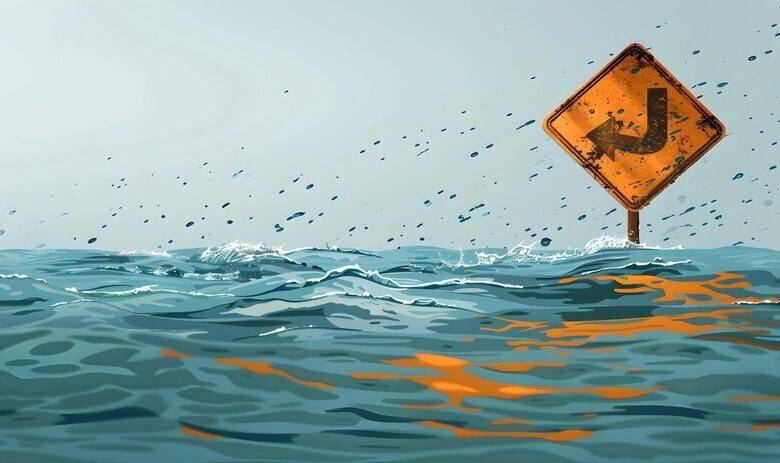A Coastal Flood Advisory is a critical warning issued when there is a likelihood of minor to moderate flooding in coastal areas. It typically stems from a combination of natural factors such as high tides, storm surges, and heavy rainfall, which cause water levels to rise beyond normal limits. These advisories are designed to alert residents of coastal areas about potential risks, enabling them to take precautionary measures to protect life and property. While they may not signal a life-threatening situation, coastal flood advisories highlight the vulnerability of coastal communities, a risk that is becoming increasingly concerning with rising sea levels and climate change.
In this article, we will explore the causes of coastal flooding, its environmental and socio-economic impacts, and the steps that can be taken for long-term preparedness.
What is a Coastal Flood Advisory?
A Coastal Flood Advisory is issued by meteorological agencies like the National Weather Service (NWS) when conditions are favorable for flooding along coastlines. The advisory alerts people that minor flooding is likely, particularly during high tides, storms, or when prolonged rainfall causes water levels to rise. It serves as a precautionary measure, often highlighting areas where low-lying streets, beachfront properties, and coastal infrastructure could be inundated with water.
While these advisories generally indicate minor to moderate flooding, they should still be taken seriously. Repeated exposure to flooding, even in small amounts, can cause long-term damage to homes, roads, and the environment. Coastal Flood Advisories also warn of potential disruptions such as road closures, water contamination, and property damage.
Causes of Coastal Flooding
Coastal flooding is driven by several interconnected natural phenomena, often exacerbated by climate change. The most common causes include:
1. High Tides and King Tides
Tides naturally fluctuate, but “king tides” represent the highest tides that occur a few times a year. These tides happen when the gravitational forces of the moon and sun align in a way that raises water levels higher than usual. When king tides coincide with other weather events like storms or heavy rainfall, the risk of flooding is amplified, leading to Coastal Flood Advisories.
2. Storm Surges
A storm surge is a significant factor in coastal flooding and occurs when strong winds from storms like hurricanes or tropical cyclones push seawater inland. The surge can drastically increase water levels, especially in low-lying coastal areas. Storm surges are particularly dangerous because they often combine with high tides, compounding the flood risk.
3. Sea-Level Rise
One of the most concerning long-term contributors to coastal flooding is the ongoing rise in sea levels. As global temperatures rise due to climate change, polar ice caps and glaciers melt, contributing to higher sea levels. Additionally, as seawater warms, it expands, further raising water levels. This gradual rise in sea levels increases the baseline water height, making even minor weather events more likely to cause flooding.
4. Heavy Rainfall
Heavy rainfall, especially when combined with high tides or storm surges, can overwhelm coastal drainage systems. In areas where rivers meet the sea, excessive rain can lead to both riverine and coastal flooding, as waterways are unable to discharge into the already swollen ocean.
Environmental and Economic Impacts
Coastal flooding has wide-ranging impacts on both the environment and local economies. Even minor floods can have cumulative effects that become more severe over time.
1. Erosion and Habitat Loss
Coastal erosion is a natural process, but frequent flooding accelerates this erosion, stripping away beaches, dunes, and wetlands. These natural barriers play a crucial role in protecting inland areas from storms and floods. As they erode, communities become more vulnerable to future events. Wetland areas, which serve as critical habitats for many species and act as buffers for storm surges, are particularly at risk.
2. Saltwater Intrusion
Frequent coastal flooding can lead to the intrusion of saltwater into freshwater systems. This is especially concerning for coastal aquifers, which provide drinking water for many communities. Saltwater contamination can render water supplies unusable and damage agricultural lands, reducing crop yields and harming local economies.
3. Property Damage
Even small-scale flooding can cause significant damage to homes, businesses, and infrastructure like roads and bridges. Repeated exposure to floodwaters weakens structures over time, leading to costly repairs and increased vulnerability to future storms. Coastal economies, particularly those dependent on tourism and fishing, suffer greatly from recurring flood events.
Long-Term Preparedness
As the risk of coastal flooding increases with rising sea levels and climate change, long-term strategies are essential for mitigating these threats.
1. Strengthening Coastal Defenses
One approach is the construction of physical barriers such as seawalls, levees, and surge barriers. While these solutions can offer immediate protection, they are expensive and often only provide temporary relief. Over time, natural forces may overcome these man-made defenses.
2. Restoring Natural Buffers
In addition to man-made defenses, restoring natural coastal barriers like wetlands, mangroves, and dunes can offer sustainable flood protection. These ecosystems absorb floodwaters and reduce the impact of storm surges, while also providing critical habitats for wildlife.
3. Zoning and Land-Use Planning
Urban planning plays a crucial role in reducing the risk of coastal flooding. Implementing zoning laws that restrict building in flood-prone areas and encouraging the development of elevated structures can prevent future losses. In some cases, managed retreat, where communities relocate away from vulnerable coastal zones, may be the best long-term solution.
4. Early Warning Systems
Advances in weather forecasting and flood modeling allow authorities to issue Coastal Flood Advisories with more accuracy, giving residents time to prepare. Governments should also ensure that evacuation plans are in place and that they can reach all residents, particularly those in vulnerable areas.
Conclusion
Coastal Flood Advisories are an essential tool for alerting communities to potential flood risks. While the advisories themselves often signal minor flooding, the growing frequency of these events highlights the need for long-term preparedness. Climate change, rising sea levels, and increased storm intensity are compounding the risks faced by coastal areas. By investing in resilient infrastructure, restoring natural defenses, and improving urban planning, coastal communities can reduce their vulnerability and protect against the increasing threat of coastal flooding.







